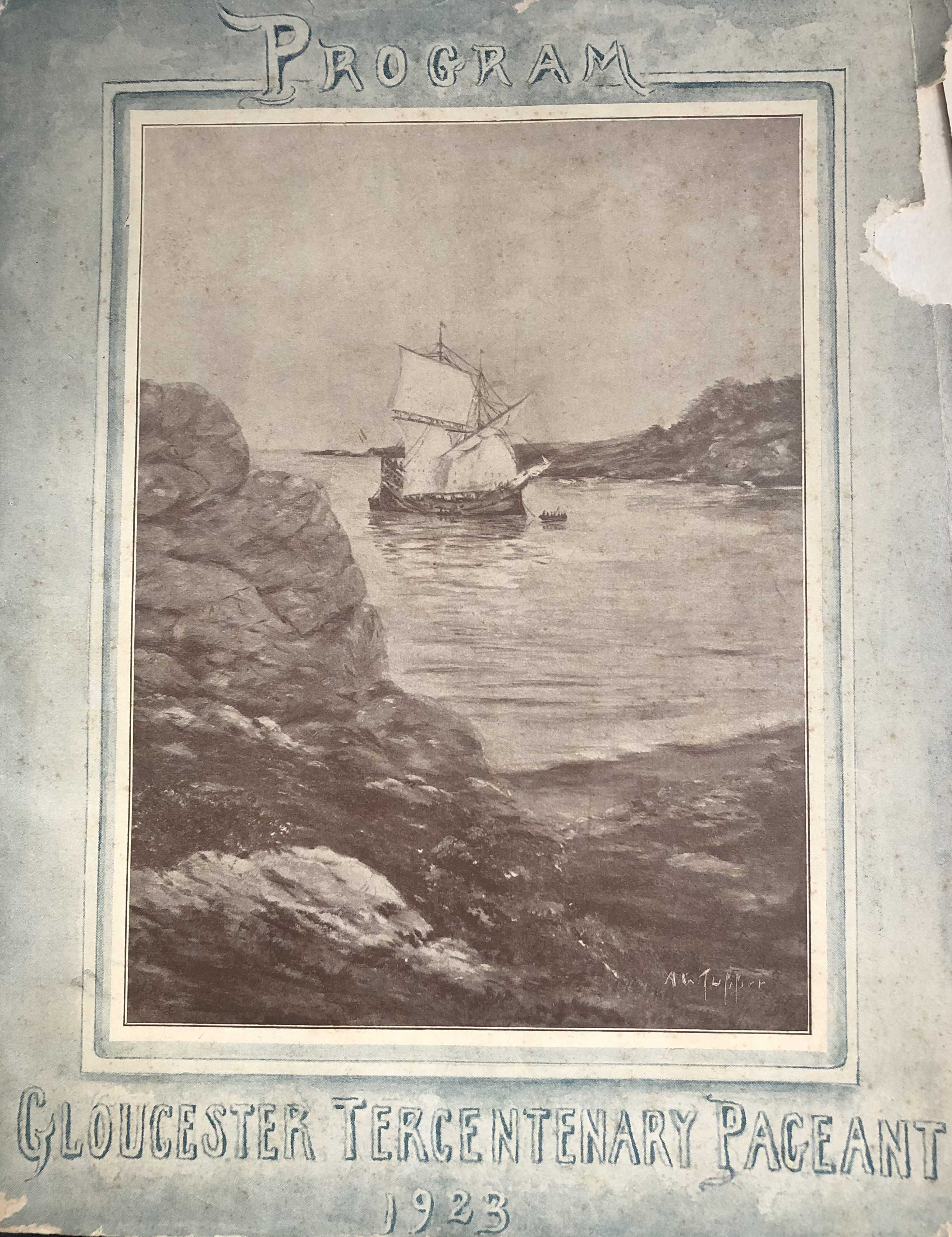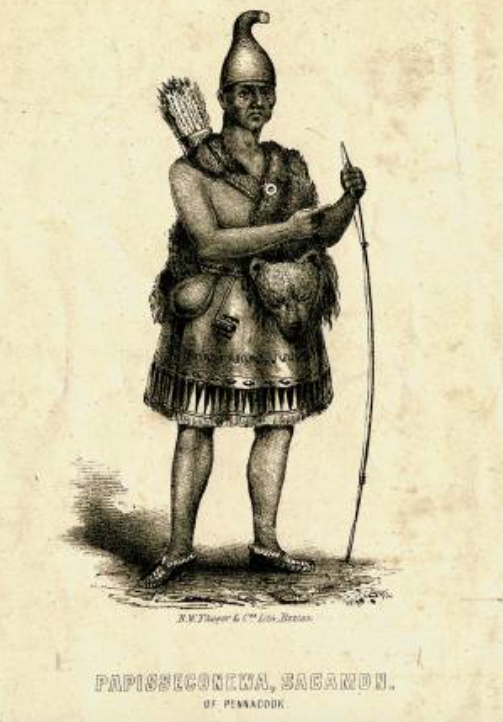The Indians of Cape Ann James R. Pringle 1923
Link to Book
 At the time of the supposed visit of Thorwald in 1004 and on the coming of Champlain to "Le Beauport" in 1606, Cape Ann was the site of a thriving Indian village. (See historical argu-ments to the Prologue and Episode 1.) When Gosnold came here in 1602 he also found the Red Men in force and ascertained to his astonishment that Portuguese fishermen had occupied the port as a fishing base as some of the savages were clad in white men's apparel. To the Portuguese, then, it appears must be given credit of being the first white men on these shores. The Portuguese early established fishing bases in Newfoundland and, without doubt, penetrated down the New England coast.
At the time of the supposed visit of Thorwald in 1004 and on the coming of Champlain to "Le Beauport" in 1606, Cape Ann was the site of a thriving Indian village. (See historical argu-ments to the Prologue and Episode 1.) When Gosnold came here in 1602 he also found the Red Men in force and ascertained to his astonishment that Portuguese fishermen had occupied the port as a fishing base as some of the savages were clad in white men's apparel. To the Portuguese, then, it appears must be given credit of being the first white men on these shores. The Portuguese early established fishing bases in Newfoundland and, without doubt, penetrated down the New England coast.
Capt. John Smith, who visited the cape in 1614, makes no mention of the Indians. When the Dorchester colony came here in 1623 the place was deserted. The only evidence of their former presence was in great heaps of clamshells near the banks of the Annisquam.
This complete disappearance is attributed to a "great plague," supposed to be small pox, which swept New England in 1615.
In "The Planter's Plea" (London, 1630) mention is made of a "three yeeres plague which swept away most of the inhabitants along the coast and in some places utterly consumed man, woman and childe so that there is no person left to lay claim to the soyle. In most of the rest the contagion had scarce left one person in a hundred." Hutchinson says, "Some tribes were in a manner extinct, the Massachusetts particularly, said by some to have been reduced from 30,000 to 300 men" and another writer, Morton, states that "the hand of God fell heavily upon them with such a mortal stroke that they died in heapes."
The Essex County Indians were a branch of the powerful Algonquins, the Agawams, their tribal seat being at Ipswich. Their chief was Masconomo, as the name is Anglicized, and they were comparatively few in number at the time of the coming of the colonists. The settlers of Cape Ann, fortunately, knew nothing of the terrors of Indian warfare.
Cape Ann, it appears, was the summer head-quarters of a tribe of Maine coast Indians. One of three chieftains, mentioned by Champlain dur-ing his visit here in 1606, was Onemechin, the Saco sachem who implored him to stay one day longer as 2000 more Indians were on their way to greet him, probably in canoes coming across Ipswich bay.
Some 25 years ago an article appeared in the local press stating that nearly a century ago the Penobscot tribe of Indians came regularly each summer to Pearce's, now Merchant's, island, voyaging down the coast in their canoes, up the river to the island, then covered with a fine growth of oak trees, spending their time in basket making, fishing, clamdigging and hun-ing. "Our informant," the article goes on to state, "often visited the Indians and recalls with pleasure the many happy incidents attending his visits and the magnificent appearance which the island then presented covered with oaks."
In the fall they returned to their winter homes with supplies of dried fish, clams, corn, etc. Up to within a short time ago the circular depressions around which they built their camps were plainly visible.
Several years ago at the head of Lobster Cove, Annisquam, an Indian burial place was uncovered and nine skeletons and a quantity of Indian relics brought to light. At Stage Fort Park, during an excavation in 1870, an Indian burial place was unearthed and a fine assortment of stone axes, arrow heads, etc., were found.
The town heard nothing from the Indians until 1701, when Samuel English, who claimed to be descendant of the original sachem who was the overlord of Cape Ann, put in an appearance and demanded compensation for his birth right. Lieut. William Stephens and Ensign Joseph Allen were deputed to make full compensation
The town heard nothing from the Indians until 1701, when Samuel English, who claimed to be a descendant of the original sachem who was the overlord of Cape Ann, put in an appearance and demanded compensation for his birth-right. Lieut. William Stephens and Ensign Joseph Allen were deputed "to make full compensation about our township with those Indians that hath laid claim to the land of our township." This was done and the next year English was paid £7 to settle his claim. The city has a copy of this original deed from which all land titles legally date. Previously, the land had been twice assigned, certain tracts being allotted for the common use. It was directed that enough of this common land be sold to raise the necessary £7 to satisfy the claim of English.
But two names of supposedly Indian origin are attached to the locality "Wonosquam" or "Annisquam" and "Wingaersheek." The first is applied to the well known summer resort on the northern side of the cape and "Wingaersheek" is Popularly supposed to be the aboriginal name of the entire headland.
There is good warrant that the name Wonosquam, softened as to spelling, was the Indian name of this section. The earliest mention of the name is in 1630-31, when Abraham Robinson's colony took up their abode there. On Wood's map, drawn in 1634, the spelling is "Anasquam" and in Josselyn's "Account of Two Voyages in New England" the name is set down as "Wondoquam." Hon. J. Hammond Trumbull, LL. D., the only person who, in recent years, could read Eliot's Indian Bible in the original, says the name is certainly derived from "Wanashaque-ornsk" which means the top or extreme point of a rock" and furthermore says the name was originally applied to the entire cape. No doubt Wood and Josselyn had interpreters from whom they obtained their information.
The words "Winne" and "Wonne" are said to signify something pleasant and "Squam," "a beautiful breaking water beach." This is the popular version and set down as such.
Just when the name "Wingaersheek" came to be applied to the cape is not clear. Certainly there is warrant for it as it has passed current for many years. Dr. Trumbull, the learned Indian authority, says the name is not of Indian origin or, if so, has become so changed as to be unrecognizable.
Several years ago the writer took up this matter with B. Mitchell, one of the leading members of the Passamaquoddy tribe of Indians, whose home is along the Maine coast. In the summer of 1900 Mr. Mitchell and a companion, following the custom of their ancestors, came into Ipswich bay on a fishing and seal hunting trip, an old law providing for a bounty on every seal killed. These Passamaquoddies, who made their summer home on Cape Ann, it appeared were of the Abenaki branch of the Algonquins.
Mr. Mitchell confirmed Trumbull that the word "Wingaersheek" is not Indian, but stated that there were Indian words of similar sound of which Wingaersheek might be a corruption.

The word "Wee-Gee-See" in the Abenaki, he pointed out meant "A place of recreation," and the word "Win-Gee-See," "the place where we cut the tree."
These were the only two words in the Indian language that in any way approximated the word Wingaersheek. The word "Win-gee-see"—the place where we cut the tree might apply to any locality.
When we examine the meaning of "Wee-gee-see"—a place of recreation we at once see its application.
So that the evidence appears to favor the derivation of the word "Wingaersheek" as it comes down to us as a euphonious form of "We-gee-see," the summer camping or vacation ground of the Indians.
Champlain's map shows that the Indians occupied and cultivated the alluvial stretch of ground, known as the Harbor Swamp from the central section of the town easterly to "The Farms."
Their huts or dwellings were not of the "tepee" type. As depicted by Champlain and described by the early settlers of other sections of the county, they were circular, 15 to 20 feet in diameter, the frame being of bent saplings, covered with birch bark, an opening being left in the top for the escape of smoke. The ground in the center was hollowed three or four feet for a fireplace.
The Indians were fond of seafood, especially shellfish, and always selected a commanding site near the water for their encampment.
The sea furnished fertilizer for their maize or corn. Their method of planting was to dig a hole in the soft alluvial earth, thrust a herring into the ground, which was covered slightly, and then plant the corn. Their nets were made from the inside bark of the willow, and from strong grass and rushes. The Pearce's island section also afforded an ample supply of the various wild berries, quantities of which were dried for use in the winter.
Of these original Indian inhabitants of Massachusetts a few descendants survive. It is the intention to have some of these participate in the Tercentenary celebration.